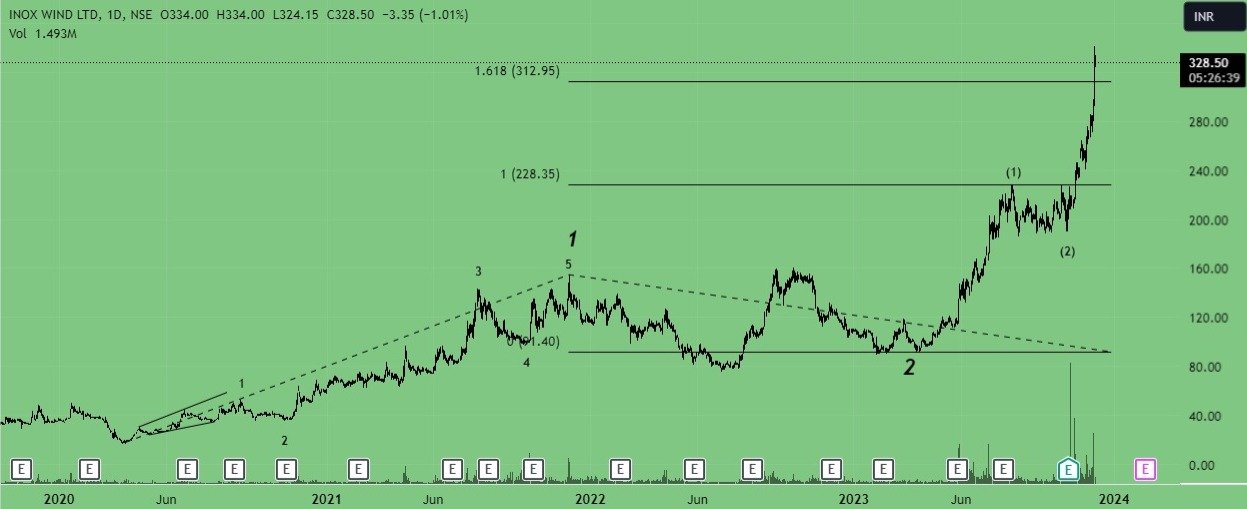Wave 3 is a crucial phase in Elliott Wave Theory, characterized by strong, extended swings and considerable momentum. It plays a fundamental role in Elliott Wave cycles and presents significant profit potential. Traders employ Fibonacci extensions to identify the target for Wave 3, specifically aiming for the 161.8% Fibonacci extension of Wave 1.
In Short
In Elliott Wave Theory, Wave 3 is when the magic occurs. The fast, quick, and aggressive momentum of this wave typically reflects strong market changes driven by heightened emotions and investor confidence.
To make the most of Wave 3, traders need to know more than just how it forms; they need to grasp its distinct character and how price action behaves inside it.
Wave 3
Wave 3 is commonly known as the powerhouse phase, characterized by powerful, prolonged swings that are ideal for strategic trading. To win during this important period, traders must understand the price movement signs that indicate its development and use well-timed tactics to maximize its potential.
How can you confidently ride this wave of rapid market change? Let’s look at some of the most important trading strategies.
Significance of 3rd Wave in Elliott Wave
Third waves of price movement can be unpredictable and powerful, requiring traders to be patient and execute stop-loss orders. In the end, chaos may ensue, with the market interpreting the news as a sign of market strength. Preparing for these unpredictable market conditions is crucial.
Here are the key aspects that highlight the significance of the 3rd wave:
1. Strong Momentum: A strong and prolonged directional movement in the main trend distinguishes the 3rd wave. It has the most powerful upward or downward speed when compared to other waves.
2. Largest Price Movement: In many cases, wave 3 covers the most distance in terms of price movement within the Elliott Wave sequence. This makes it an important time for traders and investors to profit from significant price moves.
3. Confirms Trend Direction: The formation of wave 3 confirms the overall direction of the market trend. Its strength usually confirms the impression that a substantial trend is underway, providing traders with useful information for decision-making.
4. Opportunity for Substantial Profits: Because of its prolonged length and powerful trend, wave 3 offers significant profit chances for those who can precisely recognize and ride it. Traders frequently seek entry chances during the early stages of the third wave.
5. Challenging to Identify Early: While wave 3 is a key element of Elliott Wave analysis, identifying it in its early stages can be challenging. However, successful recognition and positioning during the third wave can lead to profitable trades.
6. Followed by a Corrective Wave: Wave 4 usually follows the end of wave 3. Understanding the Wave 4 features is critical for traders expecting future retracements or consolidation periods.
The third wave is the foundation of Elliott Wave cycles, presenting significant price fluctuations and providing traders and investors with an excellent opportunity to capitalize on prevailing trends.
What Are the Wave 3 Rules?
According to Elliott Wave Theory, Wave 3 is an extended wave known for its strength and importance within a price trend. Wave identification requires a tremendous deal of expertise and research due to the theory’s intricacy. However, there are certain general rules and guidelines that Wave 3 follows.
- Wave 3 is a wave in the five-wave impulse pattern, indicating the strongest price movement in the direction of the overall trend as part of the prevailing trend.
- Wave 3 will never be the shortest. Most of the time, an extended wave occurs.
- Wave 3 is characterized by strong momentum and rapid price movement in the direction of the prevailing trend.

WAVE 3 RULES
- Wave 3’s higher volume indicates the strength of the trend, as it tends to be higher than other waves in the sequence.
- Wave 3’s length often demonstrates Fibonacci relationships with either Wave 1 or Wave 5, as seen in the example of 161.8% or 261.8% of Wave 1’s length.
How Do You Calculate Elliott Wave 3?
Calculating Elliott Wave 3 is critical for traders looking to ride the wave of momentum and profit from strong market changes. Wave 3 is usually the longest and strongest impulse wave in Elliott Wave Theory, and determining its duration and intensity involves a combination of technical analysis methods.
To begin, traders often employ Fibonacci extensions, with the minimum 1.618 extension of Wave 1 serving as a significant indication for estimating the possible length of Wave 3.
What Is the Target of Wave 3 Fib?
Elliott Wave Theory typically sets the target for Wave 3 at the 161.8% Fibonacci extension of Wave 1. This level is crucial because it represents the lowest projected duration for Wave 3, which is consistent with its impulsive and prolonged character.
If Wave 3 fails short of the 161.8% requirement, it raises questions about whether it genuinely qualifies as Wave 3 within the wider structure. Setting this Fibonacci objective helps confirm the wave’s identity and provides traders with a solid baseline for price movement projections.
Furthermore, by evaluating sub-waves inside the 5-3-5-3-5 wave structure, traders may improve their forecasts and pinpoint exact targets, capitalizing on the explosive momentum that characterizes Wave 3.
Trading Strategies in 3rd Wave
- The third wave of trading is characterized by sudden and swift price increases, with the third wave being steeper than the first wave and typically accompanied by an increase in volume.
- Maximize trading opportunities by capitalizing on the robust and sustained momentum of the third wave.
- Use Fibonacci retracement and extension levels to determine probable goals and check the strength of the third wave.

FIBONACCI EXTENSION
- Applying the 5-3-5-3-5 structure confirms the wave count and ensures the coherence of the Elliott Wave sequence.
- The objective is to carefully examine the volume patterns in order to judge the intensity and validity of the third wave’s price changes.
- The minimum aim for Wave 3 is 161 percent of Wave 1 if all requirements are satisfied.
Final Thoughts
Finally, even basic numbers reveal the mystique surrounding Elliott Wave Theory, recalling Nikola Tesla’s fascination with the number 3. Elliott Wave 3 appears as a crucial dilemma in market dynamics, much like the fascination interred in the fundamental characteristics of the number 3.
Delving into the complexities of Elliott Wave analysis reveals a common excitement among traders and investors, with Wave 3 standing out as a sought-after wave. The market, like the underlying patterns of numbers, continues to enchant individuals who explore Elliott Waves, with Wave 3 playing a vital role in this fascinating journey.
FAQ
What Is the Minimum Target of Wave 3?
According to Elliott Wave Theory, Wave 3’s minimum target is 161.8% of Wave 1’s length. This Fibonacci extension level is an important reference point for traders and analysts when determining Wave 3’s probable reach. If the length of Wave 3′ falls below this minimum level, the legitimacy of its designation as Wave 3′ may be called into question. As a consequence, setting the target at 161.8% Fibonacci gives a clear standard for confirming and analyzing the unfolding wave structure.
When Wave 3 is Extended?
Elliott Wave Theory defines Wave 3 as extended when it surpasses 161.8% of Wave 1’s length, surpasses the subsequent levels, and approaches or surpasses higher Fibonacci extension levels. Such cases identify Wave 3 as an extended wave, signifying a robust and extended period of price movement. This happens when the momentum behind Wave 3 is extremely high, resulting in a more pronounced and powerful trend that extends beyond the conventional boundaries of an impulse wave. Traders frequently see protracted Wave 3s as important possibilities for strategic market participation.
Disclaimer
This post is just for informative purposes and does not constitute financial advice. Trading and investing involve risk, and past performance does not guarantee future results. Before making an investing or trading choice, readers should undertake their own research and evaluate their own circumstances. The author and platform accept no responsibility for any financial losses or damages stemming from the use of this material. Receive personalized advice from a qualified financial advisor.















Leave a Reply